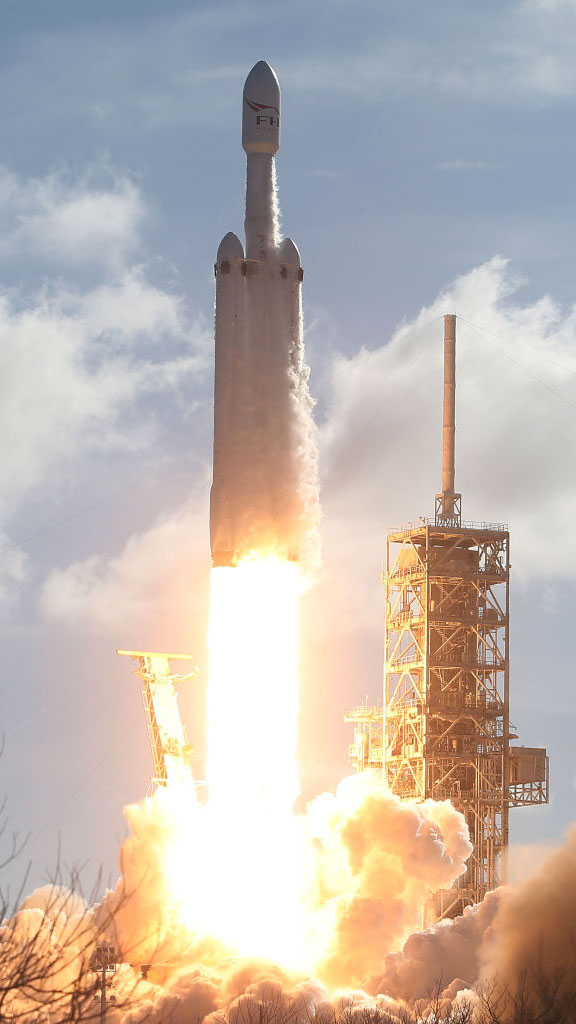Innovation: Behind the scenes at SpaceX
Behind the scenes at SpaceX
Many of us from the Apollo generation grew nostalgic February 6 at the sight of the gleaming white SpaceX Falcon Heavy thundering off launch complex 39A at Kennedy Space Center in Cape Canaveral, Florida. The cheers, screams, tears, and amazed smiles from thousands lining the Cape roadways; the classically blue Florida sky; and the team in mission control hugging and jumping in excitement—it could have been an Apollo Saturn V rocket sending three astronauts to the moon in 1972. Instead it was the first launch of the most powerful operational rocket system since those heady days, an event that opens the door for a return to the moon, and, if SpaceX founder Elon Musk has his way—and he usually does—our ride to Mars, a place ready for colonization.
 The Falcon Heavy payload? Not three strapping young men in bulky NASA space suits, but Musk’s personal Tesla Roadster, the top down. Inside is a crash test dummy named “Starman” in a tailored SpaceX spacesuit, his arm resting casually on the doorframe while a loop of David Bowie’s Space Oddity blasts loudly; a sign on the dash proclaims “Don’t Panic,” a nod to the cult novel Hitchhiker’s Guide to the Galaxy. The sports car will forever cruise in an elliptical orbit around the sun and Mars. A week after the launch, it was some 333,000 miles from Earth and traveling at a brisk 8,243 miles per hour—a personal homerun for Musk, who is also the founder of Tesla (www.whereisroadster.com).
The Falcon Heavy payload? Not three strapping young men in bulky NASA space suits, but Musk’s personal Tesla Roadster, the top down. Inside is a crash test dummy named “Starman” in a tailored SpaceX spacesuit, his arm resting casually on the doorframe while a loop of David Bowie’s Space Oddity blasts loudly; a sign on the dash proclaims “Don’t Panic,” a nod to the cult novel Hitchhiker’s Guide to the Galaxy. The sports car will forever cruise in an elliptical orbit around the sun and Mars. A week after the launch, it was some 333,000 miles from Earth and traveling at a brisk 8,243 miles per hour—a personal homerun for Musk, who is also the founder of Tesla (www.whereisroadster.com).
When I interviewed aerospace reporter Miles O’Brien a few days after the launch, he made an interesting observation about the young engineers cheering from the control room. They are, in essence, the grandchildren of those young faces we saw during Apollo launches. Instead of white dress shirts and skinny black ties, the new generation was dressed casually but was every bit as excited about their mission.
I saw that enthusiasm three weeks before the launch when I toured the SpaceX factory and headquarters next to the general aviation airport in Hawthorne, California. There, the former Northrop factory has been transformed into a vertically integrated rocket factory.
While NASA contracted with companies all over the country to build its rockets, SpaceX builds virtually everything under that one roof—the engines, the rockets, the capsules, and everything needed to launch and control them. The complex even includes a refurbishment facility—something NASA never needed to consider for its throw-away rockets. Many parts of the SpaceX rockets are meant to be recovered and reused, dramatically lowering launch costs, one of Musk’s primary goals. And it works. It would cost about $1 billion to launch a Saturn V. A Falcon Heavy can break the surly bonds for about $90 million.
The Heavy consists of three nine-engine cores; the two boosters on the sides of the main core are each equivalent to the first stage of a Falcon 9 rocket (and yes, it is named after the Millennium Falcon of Star Wars fame). On the first Heavy launch, the two boosters returned nearly at the same time back to the space center for what appeared to be a choreographed arrival. The center core, like some earlier Falcon 9s, was supposed to land on an unmanned barge parked at sea, but it slipped off and was lost.
The first Heavy launch was an amazing success that gives hope to Musk’s vision of slingshotting paying passengers around the moon, transporting tourists to orbiting hotels, sending passengers from Florida to Tokyo in 40 minutes, and establishing habitats on Mars.
Hey, who’s to argue with a guy who can put a car in orbit around the sun? The launch gives Musk bragging rights for infinity—that Tesla has the fastest car in the universe.
Email [email protected]
